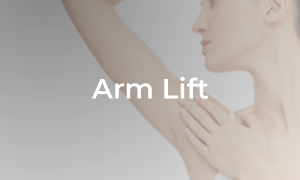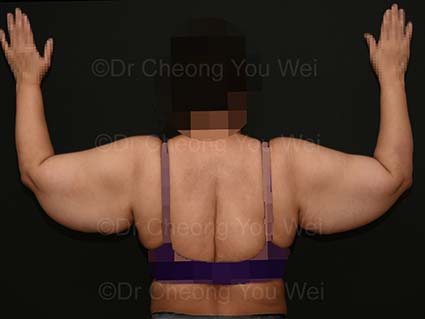Arm Lift
- Before
- After
- Before
- After
Massive weight loss, aging and sometimes heredity can cause the skin of the arms to become loose and saggy. In severe cases, the saggy skin hangs down from the side of the arm, causing a ”bat-wing” or butterfly-wing” appearance. This condition can occur with or without excess fat in the arm. While exercise may improve underlying muscle tone and liposuction can remove excess fat, they are unable to remove excess skin in the arms.
An arm lift, also known as brachioplasty, is a surgical procedure that remove excess skin and fatty tissue in the arms. An arm lift is an effective treatment to reduces excess skin and fat in the arm and reshape the arm to become slimmer and smoother. The aim is to create a slim, firm and well-sculpted arm.
Preparation
-
Inform the doctor of any pre-existing medical conditions and drug allergy. All medical conditions must be treated and stabilized before surgery.
-
Stop smoking at least one week before surgery. Smoking is harmful to wound healing and increases the risks of other post-operation complications.
-
Stop the following medications and supplements from one week before surgery until one week after surgery.
-
All supplements containing vitamin E, ginseng, ginkgo, garlic, fish oil, and other ingredients that increase bleeding during the procedure. Other supplements, traditional medicine, and herbs, in which ingredients are unknown, have to stop as well.
-
Medicine that increases bleeding during the procedure such as aspirin, NSAIDs, and warfarin. However, you may need to consult your physician who prescribed the medication before you stop them.
-
-
On the day of surgery, wear simple and comfortable clothing. Do not wear any makeup. Do not wear any jewelry and metal objects on the face and body.
Surgery
Duration: 2-4 hours
Anaesthesia: General Anaesthesia or local anaesthesia depending on the extent of surgery
Hospitalization: one day
Recovery: Back to work in 7 days, light exercise after one to 2 weeks, heavy exercise after at least one month. * The actual recovery speed may vary from person to person.
Technique: The length and pattern of the incision during arm lift surgery depend on the amount and location of excess skin to be removed. Incisions are placed on the inside of the arm and may extend from the armpit to just above the elbow. Excess fat is removed by liposuction.
-
Mini Arm Lift: The incision site is located in the armpit, where it is hidden from view. A mini arm lift is the appropriate solution for those who have moderate excess skin limited to the upper arm.
-
Standard Arm Lift: A liposuction is performed first. This is followed by incisions on the inner aspect of the upper arms which extend from the armpit to the elbow. A long ellipse of skin and underlying fat is removed. The wound margins are closed with precise suturing for optimal scar healing. This procedure is recommended for moderate and severe cases.
-
Extended Arm Lift: Besides standard arm lift incisions, there are extra incisions extend into the flank of the upper chest to remove excess loose skin around the arm, armpit, and upper chest. Extended arm lift is reserved for patients with severe skin excess and laxity in the arm, armpit and the adjacent chest.
Post-operative Care**
-
What to expect: Swelling usually peaks on the second to third day after surgery and will gradually subside after that. Tight sensation in the arms may be present for one to 2 weeks.
-
General care:
-
Use a supportive garment to support the arms for the first month.
-
Avoid smoking for at least one month. Smoking increases the risk of wound complications.
-
Sleep on the back and avoid sleeping on one side.
-
Adequate rest and sleep are helpful for a speedy recovery.
-
Be relaxed and calm. Contact the clinic if there are any queries.
-
-
Medicine: Finish the oral antibiotics as prescribed. Take the painkiller as prescribed when necessary.
-
Wound care: After removing the wound dressing, clean the wound with a clean cotton tip soaked with sterile water/saline. Apply antibiotic ointment.
-
Physical activity: Avoid heavy physical activity and exercise for at least one month.
-
Follow-up: Come back one week after surgery for review.
-
Emergency: If there is heavy bleeding, a rapid increase in swelling or severe pain, immediately contact the clinic/doctor for advice.
** The instructions in this list are only for general guidance. If you have any specific queries or concerns during the post-operative recovery, please contact the clinic for further advice.












